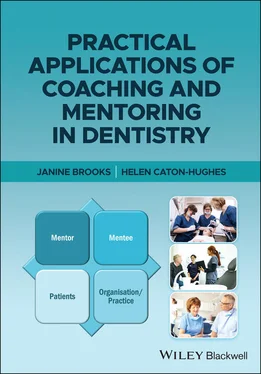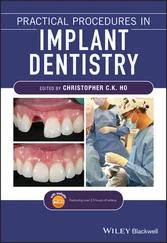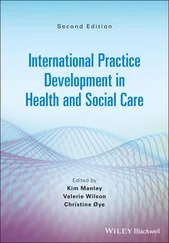Mentoring is increasingly being seen by organisations generally, and the dental profession in particular, as a way of helping and supporting the development of people (employees, staff, contractors, patients) to achieve their goals. The word mentor has come to mean trusted adviser, friend, teacher, and wise person. The term ‘coach’ has been more commonly associated with someone supporting personal and professional performance, goal achievement, and drive. We aim to broaden both these terms to encompass enhanced self‐awareness, development, personalised learning, and excellence in practise.
In dentistry we are still at the beginning of appreciating the potential and benefits of mentoring. In our experience more and more dental professionals are undertaking training to become mentors, such that these skills are applied more intentionally and more professionally. As will become evident as you read through the book, great mentors combine skill, expertise, and experience with the skills of mentoring in the service of another individual, the mentee. The practical skills, expertise, and experience that others wish to learn and emulate will not be covered by the book, they are taken as present. What the book does cover are the skills of translating that expertise and experience into a worthwhile, productive conversation, and relationship that promotes growth and development of another individual, the mentee.
Mentoring has slowly been gaining a position within dentistry since the Millennium with more and more dental professionals becoming familiar with the term and the concept of mentoring. It is also good to see this recognition from the statutory regulator for dental professionals.
Activities such as coaching and mentoring, where individuals are supported by other members of the dental profession, also have an important role to play here, and are valuable ways of enhancing the skills and approach of all involved.
Shifting the Balance: a better, fairer system of dental regulation
(GDC 2017).
Vernon Holt did much to champion mentoring within the dental profession and his series of articles written between 2008 and 2010 are referenced frequently through the literature. Holt produced his thesis in 2013 and it contains a rich mine for those wishing to know more about mentoring in dentistry.
I suggest that a culture proactively supportive of practitioners at all stages of their careers using routine mentoring could do more than any amount of audit of techniques, protocols or choosing of ‘the latest’ materials, to enhance the quality of care delivered. Furthermore, because the dentist has a leadership role in the practising environment, the quality of performance of the dentist in the team can have a profound effect on the morale and culture of the team of which he or she is a part. This in turn will influence the quality of patient care indirectly as well as the direct effect through his/her own clinical performance
(Holt 2013, p. 24).
It is from the 1980s that we start to see the emergence of a body of literature about mentoring in American business management (Colley 2002). Influential articles, particularly Roche's report, Much Ado about Mentoring (1979), claimed to have discovered mentoring as an informal but important part of a businessman's career. Mentoring in Britain then began to be seen as an American import, which had to be adapted to British culture. Clutterbuck was instrumental in the 1980s in bringing the idea of mentoring to Britain from the United States. He is regarded as the ‘grandfather’ of mentoring in the UK.
There is also anecdotal evidence to suggest that Continuing Professional Development (CPD) which involves interaction with professional colleagues has significant benefits when compared with other non‐interactive activities, e.g. reading, or online CPD. While there is room for a mix of CPD activity, we all need to consider how to ensure that the benefits of interactive CPD are recognized and realised. Activities such as coaching and mentoring, where individuals are supported by other members of the dental profession, also have an important role to play here, and are valuable ways of enhancing the skills and approach of all involved
(GDC Moving upstream 2020, p. 32).
Considering the widely varying circumstances and professional isolation of general dental practice, the most adaptable tool for supporting the quality of performance of dentists is likely to be mentoring
(Holt 2013, p. 34).
Experience since Holt wrote the above sentence has shown that the potential for mentoring goes beyond quality performance. The case study examples in Chapter 5highlight the following areas of benefit:
Career development
Quality assurance
Improving communication
Deepening insight and self‐awareness
Excellence
Remediation of poor performance.
These are also explored further in the discussion chapter.
It's not only the dental practices that benefit from mentoring, the 2004 National Health Service (NHS) national staff survey (Healthcare Commission 2005) noted that 17% of staff identified that they had received training and development from a mentor during the previous 12 months.
The Department of Health, NHS knowledge and skills framework and development review (2004, p. 8) highlighted two key messages that relate to mentoring:
Mentoring is key to the future of the NHS.
A national framework for mentoring is to be created.
Viney and Paice (2010, p. 38) reporting on the London Deanery ‘First Five Hundred’ mentees concluded: ‘The first five hundred mentees have confirmed our conviction that this service is needed and appreciated by a significate number of doctors and dentists ’ .
Increasingly, as clinical leadership grows, the use of mentoring and coaching to support leadership development is also growing. Many leadership programmes for health professionals now including a blend of training, development, mentoring, and coaching, as well as training for clinical leaders in mentoring and coaching skills.
Distinctions and Boundaries
As Clutterbuck outlined in 2001, there is considerable confusion over what mentoring is and what it is not. It can often be confused with other methods of professional support.
Here we make clear distinctions between counselling, advice‐giving, coaching, and other ‘talking’ interventions. The distinctions focus on three key elements of mentoring:
The type of support and level of advice that a Mentor gives a Mentee.
The way in which support and advice is offered.
The role(s) which the Mentee expects the Mentor to play.
For example:
Counsellors tend to work with clinical issues and go back to the past before going forward. It's often a one‐way relationship, with therapeutic intention.
Mentors and coaches work with successful, healthy people and start in the present, then go to the future. In both cases, a two‐way relationship is established – for example, mentors and coaches will share personal information and experience.
Coaching encourages a partnership approach in the conversation, whereas a mentor, by dint of experience, knowledge, and connections, has greater perceived status and power than the mentee.
The divide between mentoring and coaching is less clear cut. Both work by encouraging self‐discovery and self‐resolution. A mentor is more likely to be an expert in the field and has been chosen because the mentee will look for advice and guidance from the mentor. A coach does not need to have any subject knowledge in order to produce results.
The range of skills or approaches used in mentoring may include training, advice, and career counselling. Understanding the distinctions between counselling, advice‐giving, coaching, and other ‘talking’ interventions is important.
Читать дальше












